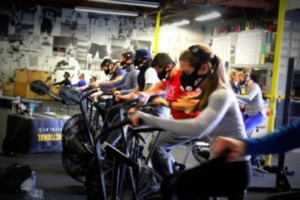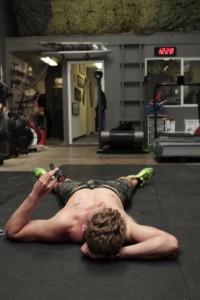By Brian MacKenzie and Rachael Colacino
As we enter spring competition and race season, now is the time to refine and learn how to mentally and physically tap into your best self. You have put in the time honing in your technique, fixing your metabolic holes, and building your power, strength and endurance. Now is time to expose your true performance potential.
In order to access your 100 percent you need to have a good breathing practice. We typically only become conscious of our breathing when we are breathing hard or can’t breathe at all. But adding in a breath practice before, during and after competition and training can help performance and recovery. It can also make you a healthier, more conscious athlete, which can help expose your true potential.
Below are some of the breathing protocols we are having our PSE PRO athletes use to prepare, pace and recover after their most difficult time trials, races and training sessions. Test them out in training before your important race. Keep in mind that we are all different — what works for one athlete may not work for you. Experiment on yourself and keep track of what works; discard anything that doesn’t.
Before the Workout
The Goal:
Before any high-profile, competition-level workout, your goal is to inflate your oxygen levels. The key is that you also need to release that oxygen. We want to stimulate our pulmonary system so that it works in tandem with our muscular and cardiovascular systems. You know that point in your workout where you’re finally breathing in rhythm after 20 minutes of riding the struggle bus? That’s the point at which your breath and muscles finally are in sync. Breathing practice before a workout will get you there sooner.
We’ve experimented with superventilation (hyperventilation practices) sequences (such as Wim Hof, Holotropic, and Breath of Fire), which are all highly effective breathing methods. The issue we’ve seen in using some of the sequences before competition is that the corresponding effect of holding our breaths for maximal time increases carbon dioxide levels and then lowers O2 levels, which inevitably lowers pH or creates a more acidic environment. This process releases stored O2 once CO2 begins to rise dramatically. If you do perform breath holds before a workout, try not to exceed one minute at a time. Anything longer than that can potentially cannibalize the oxygen you’re releasing and will leave you where you may have started or even less O2 efficient.
Try This:
 After a warmup of 5 to 10 minutes of aerobic work, find a breathing sequence with a long enough inhale and exhale that just starts to stress your system. Or use a resistance breathing device. Your inhale should be slow and controlled, with a pause at the top. Then slowly release your breath. Find a rhythm that starts to challenge you. Another option: perform your entire warm up with nasal breathing only.
After a warmup of 5 to 10 minutes of aerobic work, find a breathing sequence with a long enough inhale and exhale that just starts to stress your system. Or use a resistance breathing device. Your inhale should be slow and controlled, with a pause at the top. Then slowly release your breath. Find a rhythm that starts to challenge you. Another option: perform your entire warm up with nasal breathing only.
Another option to increase oxygen availability would be trying the following breathing cadence sequence prior to training or competing: 3-second inhale/3-second breath hold/6-second exhale/3-second pause at the end. Repeat for 5-10 rounds. Do not exceed a 6-second exhale.
If your competition involves heavy lifts, perform a bracing sequence before you begin. An example would be a 5-second inhale, a 20-second breath hold, and a 10-second exhale, or adjust to a 1, x4, x2 sequence that best suits you. During the breath hold, focus on proper bracing with full air and the position of your braced core to transfer that to your heavy lifts.
During the Workout
The Goal:
During your competition or race, your task is to consume as much air as you can and to avoid hyperventilation and its short, choppy breaths.
Try This:
As soon as the clock starts, draw your air in quickly, and make sure it’s a full breath. Exhale that air promptly, leaving a small pause at the end. Breathing through your mouth is fine. For the more conditioned athlete this can be done via nasal breathing only. Focus on a full breath of air to fill your lungs to the end range, which will allow the alveoli at full range of the lungs to get more O2/CO2 to exchange. If you’re not getting full breaths of air, you’re missing out on a lot of oxygen utilization.
After the Workout
Try This:
 After your workout, the goal is to downregulate as quickly as possible. Cool down by taking a walk and taking in deep, controlled breaths. Once your breathing is under control, lie down and focus on nasal in full breaths of air with nasal exhales of 7 seconds minimum. This will allow your body to recover effectively and hastily. Follow that with a superventilation sequence of 3 minutes of nasal inhales and exhales, and then a 30-second breath hold at the end. This will return your body to a parasympathetic state and speed your recovery.
After your workout, the goal is to downregulate as quickly as possible. Cool down by taking a walk and taking in deep, controlled breaths. Once your breathing is under control, lie down and focus on nasal in full breaths of air with nasal exhales of 7 seconds minimum. This will allow your body to recover effectively and hastily. Follow that with a superventilation sequence of 3 minutes of nasal inhales and exhales, and then a 30-second breath hold at the end. This will return your body to a parasympathetic state and speed your recovery.
Want to learn more about breath work and application?
Attend one of our Art of Breath clinics or take the Art of Breath Online course.
